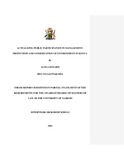| dc.description.abstract | The principle of public participation has generally been accepted as a foundational value for democratic governance. The principle has gained particular traction in environmental governance owing to the failure of the command and control system by the state to guarantee environmental justice.
The UN Conference on Environment and Development held in Rio de Janeiro in 1992 set the pace by providing that “Environmental issues are best handled with the participation of all concerned citizens, at the relevant level. At the national level, each individual shall have appropriate access to information concerning the environment that is held by public authorities, including information on hazardous materials and activities in their communities, and the opportunity to participate in decision-making processes. States shall facilitate and encourage public awareness and participation by making information widely available. Effective access to judicial and administrative proceedings, including redress and remedy, shall be provided.” This implies that governments have an obligation to involve citizens in decisions which an impact on their health and environment.
In Kenya, the principle of public participation has been entrenched in the Constitution (2010). From the onset the Constitution asserts that sovereign power is vested in the people of Kenya. It is set as one of the national values and principles of governance binding on all state organs, public officers and all persons. The principle has become an inherent of sustainable development meaning that attainment of sustainability requires the participation of all citizens during decision making processes.
The implementation and effectiveness of public participation depends on the legal, statutory and institutional frameworks which have been put in place. This study interrogates the legal framework in place for public participation in environmental governance in Kenya.
As a case study, the researcher appraises the successes and challenges of the concept of participatory forest management (PFM) introduced by the Forest Act (2005). Towards this endevour, the researcher conducted interviews and focus group discussions in two urban forests where the concept is being implemented. | en_US |



